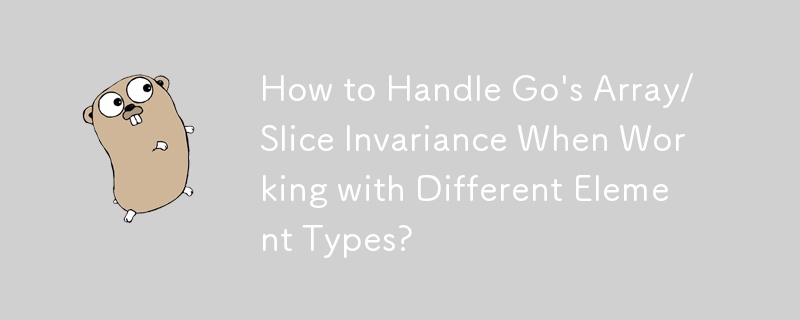 Backend Development
Backend Development
 Golang
Golang
 How to Handle Go's Array/Slice Invariance When Working with Different Element Types?
How to Handle Go's Array/Slice Invariance When Working with Different Element Types?
How to Handle Go's Array/Slice Invariance When Working with Different Element Types?

Handling Array/Slice Invariance in Go
In Go, one may encounter challenges working with arrays or slices of different element types. Consider the following example:
func printItems(header string, items []interface{}, fmtString string) {
// ...
}
func main() {
var iarr = []int{1, 2, 3}
var farr = []float{1.0, 2.0, 3.0}
printItems("Integer array:", iarr, "")
printItems("Float array:", farr, "")
}Upon compiling this code, you'll encounter errors due to Go's lack of array/slice covariance. Specifically:
prog.go:26: cannot use iarr (type []int) as type []interface { } in function argument
prog.go:27: cannot use farr (type []float) as type []interface { } in function argumentA Flexible Solution
One approach to circumventing this issue is to define an interface that abstracts the common attributes of these arrays/slices:
package main
import "fmt"
type List interface {
At(i int) interface{}
Len() int
}
func printItems(header string, items List) {
for i := 0; i < items.Len(); i++ {
fmt.Print(items.At(i), " ")
}
fmt.Println()
}
type IntList []int
type FloatList []float64
func (il IntList) At(i int) interface{} { return il[i] }
func (fl FloatList) At(i int) interface{} { return fl[i] }
func (il IntList) Len() int { return len(il) }
func (fl FloatList) Len() int { return len(fl) }
func main() {
var iarr = []int{1, 2, 3}
var farr = []float64{1.0, 2.0, 3.0}
printItems("Integer array:", IntList(iarr))
printItems("Float array:", FloatList(farr))
}By encapsulating the behavior of these collections in an interface, you can access and manipulate them generically. This approach remains idiomatic within Go while providing the flexibility needed for handling different data types.
The above is the detailed content of How to Handle Go's Array/Slice Invariance When Working with Different Element Types?. For more information, please follow other related articles on the PHP Chinese website!

Hot AI Tools

Undresser.AI Undress
AI-powered app for creating realistic nude photos

AI Clothes Remover
Online AI tool for removing clothes from photos.

Undress AI Tool
Undress images for free

Clothoff.io
AI clothes remover

AI Hentai Generator
Generate AI Hentai for free.

Hot Article

Hot Tools

Notepad++7.3.1
Easy-to-use and free code editor

SublimeText3 Chinese version
Chinese version, very easy to use

Zend Studio 13.0.1
Powerful PHP integrated development environment

Dreamweaver CS6
Visual web development tools

SublimeText3 Mac version
God-level code editing software (SublimeText3)

Hot Topics
 How do I write mock objects and stubs for testing in Go?
Mar 10, 2025 pm 05:38 PM
How do I write mock objects and stubs for testing in Go?
Mar 10, 2025 pm 05:38 PM
This article demonstrates creating mocks and stubs in Go for unit testing. It emphasizes using interfaces, provides examples of mock implementations, and discusses best practices like keeping mocks focused and using assertion libraries. The articl
 How can I define custom type constraints for generics in Go?
Mar 10, 2025 pm 03:20 PM
How can I define custom type constraints for generics in Go?
Mar 10, 2025 pm 03:20 PM
This article explores Go's custom type constraints for generics. It details how interfaces define minimum type requirements for generic functions, improving type safety and code reusability. The article also discusses limitations and best practices
 How do you write unit tests in Go?
Mar 21, 2025 pm 06:34 PM
How do you write unit tests in Go?
Mar 21, 2025 pm 06:34 PM
The article discusses writing unit tests in Go, covering best practices, mocking techniques, and tools for efficient test management.
 How do you use the pprof tool to analyze Go performance?
Mar 21, 2025 pm 06:37 PM
How do you use the pprof tool to analyze Go performance?
Mar 21, 2025 pm 06:37 PM
The article explains how to use the pprof tool for analyzing Go performance, including enabling profiling, collecting data, and identifying common bottlenecks like CPU and memory issues.Character count: 159
 How can I use tracing tools to understand the execution flow of my Go applications?
Mar 10, 2025 pm 05:36 PM
How can I use tracing tools to understand the execution flow of my Go applications?
Mar 10, 2025 pm 05:36 PM
This article explores using tracing tools to analyze Go application execution flow. It discusses manual and automatic instrumentation techniques, comparing tools like Jaeger, Zipkin, and OpenTelemetry, and highlighting effective data visualization
 Explain the purpose of Go's reflect package. When would you use reflection? What are the performance implications?
Mar 25, 2025 am 11:17 AM
Explain the purpose of Go's reflect package. When would you use reflection? What are the performance implications?
Mar 25, 2025 am 11:17 AM
The article discusses Go's reflect package, used for runtime manipulation of code, beneficial for serialization, generic programming, and more. It warns of performance costs like slower execution and higher memory use, advising judicious use and best
 How do you use table-driven tests in Go?
Mar 21, 2025 pm 06:35 PM
How do you use table-driven tests in Go?
Mar 21, 2025 pm 06:35 PM
The article discusses using table-driven tests in Go, a method that uses a table of test cases to test functions with multiple inputs and outcomes. It highlights benefits like improved readability, reduced duplication, scalability, consistency, and a
 How can I use linters and static analysis tools to improve the quality and maintainability of my Go code?
Mar 10, 2025 pm 05:38 PM
How can I use linters and static analysis tools to improve the quality and maintainability of my Go code?
Mar 10, 2025 pm 05:38 PM
This article advocates for using linters and static analysis tools to enhance Go code quality. It details tool selection (e.g., golangci-lint, go vet), workflow integration (IDE, CI/CD), and effective interpretation of warnings/errors to improve cod






